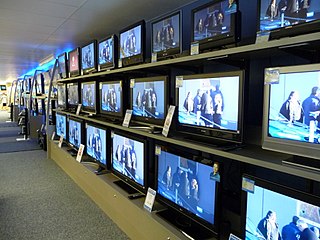
Video art is an art form which relies on using video technology as a visual and audio medium. Video art emerged during the late 1960s as new consumer video technology such as video tape recorders became available outside corporate broadcasting. Video art can take many forms: recordings that are broadcast; installations viewed in galleries or museums; works streamed online, distributed as video tapes, or DVDs; and performances which may incorporate one or more television sets, video monitors, and projections, displaying live or recorded images and sounds.
Media ecology theory is the study of media, technology, and communication and how they affect human environments. The theoretical concepts were proposed by Marshall McLuhan in 1964, while the term media ecology was first formally introduced by Neil Postman in 1968.

Understanding Media: The Extensions of Man is a 1964 book by Marshall McLuhan, in which the author proposes that the media, not the content that they carry, should be the focus of study. He suggests that the medium affects the society in which it plays a role mainly by the characteristics of the medium rather than the content. The book is considered a pioneering study in media theory.

Robert Greenwald is the founder of Brave New Films, a nonprofit film and advocacy organization whose work is distributed for free in concert with nonprofit partners and movements in order to educate and mobilize for progressive causes. The work of Brave New Films has been screened over seven continents and viewed over tens of millions of times and counting. His most recent full-length feature documentary, illustrates the connection between gun industry profits and gun deaths in America. The studio is currently working with a coalition in California opposed to the money bail system with films like Debunking Bail Myths. Brave New Films is also continuing its history of political advocacy by presenting short documentaries on current events from a progressive perspective, e.g. a piece on Donald Trump's cabinet picks.
Modern warfare is warfare using the concepts, methods, and military technology that have come into use during and after World Wars I and II. The concepts and methods have assumed more complex forms of the 19th- and early-20th-century antecedents, largely due to the widespread use of highly advanced information technology, and combatants must modernize constantly to preserve their battle worthiness. Although total war was thought to be the form of international conflicts from the experience of the French Revolutionary Wars to World War II, the term no longer describes warfare in which a belligerent use all of its resources to destroy the enemy's organized ability to engage in war. The practice of total war which had been in use for over a century, as a form of war policy, has been changed dramatically with greater awareness of tactical, operational, and strategic battle information.
Radical Software was an early journal on the use of video as an artistic and political medium, started in 1970 in New York City. At the time, the term radical software referred to the content of information rather than to a computer program.
In publishing, art, and communication, content is the information and experiences that are directed towards an end-user or audience. Content is "something that is to be expressed through some medium, as speech, writing or any of various arts". Content can be delivered via many different media including the Internet, cinema, television, smartphones, audio CDs, books, e-books, magazines, and live events, such as speeches, conferences, and stage performances.
Guerrilla theatre, generally rendered "guerrilla theater" in the US, is a form of guerrilla communication originated in 1965 by the San Francisco Mime Troupe, who, in spirit of the Che Guevara writings from which the term guerrilla is taken, engaged in performances in public places committed to "revolutionary sociopolitical change." The group performances, aimed against the Vietnam war and capitalism, sometimes contained nudity, profanity and taboo subjects that were shocking to some members of the audiences of the time.

Systems art is art influenced by cybernetics, and systems theory, that reflects on natural systems, social systems and social signs of the art world itself.

Il costume di casa was originally an essay written by the Italian semiotician Umberto Eco, about "America's obsession with simulacra and counterfeit reality." It was later incorporated as the centrepiece of the anthology bearing the same name, a collection of articles and essays about Italian ideologies. The anthology contains a selection of essays taken from two Italian books by Eco: Il costume di casa and Sette anni di desiderio (1983). It was translated into English in 1986 as Faith in Fakes and later updated as Travels in Hyperreality in 1995.
Dara Greenwald (1971–2012) was an interdisciplinary artist with a PhD in Electronic Arts from Rensselaer Polytechnic Institute, an MFA in writing from the School of the Art Institute in Chicago, and a BA in Women's Studies from Oberlin College. Her collaborative work involved video, writing, public art, activism and cultural organizing.
Television Delivers People is a 1973 short film made by video artist Richard Serra and Carlota Fay Schoolman. Running just short of 7 minutes in English, it is a single channel video art piece. The two artists bought some airtime to broadcast the piece to the public in 1973. To the soundtrack of canned, conventional elevator music, electronically generated text scrolls over the screen in yellow font with a blue background. This format of text and the successful use of minimal video technology gives the feel of a "spare low-budget appearance, as if it were an information bulletin, or a pre-programme transmission on a community TV channel or cable network. Because of this minimal 'look', the tape clearly originates from 'outside' the broadcast TV environment, therefore deconstructing not so much the form of television programming but rather the broadcasting's overall strategy".
Frank Gillette is an American video and installation artist. Interested in the empirical observation of natural phenomena, his early work integrated the viewer's image with prerecorded information. He has been described as a "pioneer in video research [...] with an almost scientific attention for taxonomies and descriptions of ecological systems and environments". His seminal work Wipe Cycle –co-produced with Ira Schneider in 1968– is considered one of the first video installations in art history. Gillette and Schneider exhibited this early "sculptural video installation" in TV as a Creative Medium, the first show in the United States devoted to Video Art. In October 1969, Frank Gillette and Michael Shamberg founded the Raindance Corporation, a "media think-tank [...] that embraced video as an alternative form of cultural communication.

Mary Curtis Ratcliff is an American visual artist.













